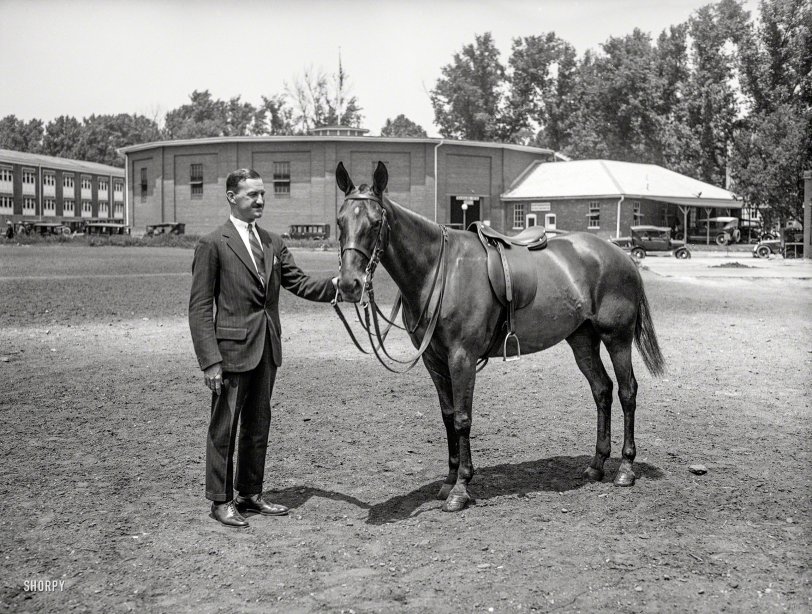


Framed or unframed, desk size to sofa size, printed by us in Arizona and Alabama since 2007. Explore now.
Shorpy is funded by you. Patreon contributors get an ad-free experience.
Learn more.

- Baldwin 62303
- Baldwin VO-1000
- Cold
- No expense spared
- Tough Guys
- Lost in Toyland
- And without gloves
- If I were a blindfolded time traveler
- Smoke Consumer Also Cooks
- Oh that stove!
- Possibly still there?
- What?!?
- $100 Reward
- Freeze Frame
- Texas Flyer wanted
- Just a Year Too Soon
- WWII -- Replacing men with women at the railroad crossing.
- Yes, Icing
- You kids drive me nuts!
- NOT An Easy Job
- I wonder
- Just add window boxes
- Icing Platform?
- Indiana Harbor Belt abides
- Freezing haze
- Corrections (for those who care)
- C&NW at Nelson
- Fallen Flags
- A dangerous job made worse
- Water Stop
Print Emporium
Gift Horse: 1925

May 1925. "Major John G. Quekemeyer, formerly aide-de-camp to General Pershing, with 'Argentina,' a 6-year-old Polo pony given to him by the Minister of War of the Argentine Republic, General Justo. The General presented six ponies while he was in South America." Harris & Ewing glass negative. View full size.
OUCH.
All four of Argentina's hooves have laminitic ridges... :-(
Crack Polo Player
John Quekemeyer had an exemplary early career in the U.S. Army. If not for his untimely death ten months after this photo, his name might have become as familiar as Patton, Eisenhower and MacArthur.
Associated Press, February 28, 1926.Pershing War Aide Dies of Pneumonia
Major Quekemeyer Succumbs At
West Point Academy Hospital.Major John G. Quekemeyer, who was aide to General Pershing in the World War, died in the Military Academy Hospital here today of pneumonia. He was 41 years old. He came to West Point to succeed Gen. March Stewart as commandant of cadets on April 1, when General Stewart will succeed Gen. Fred Sladen as superintendent of the academy.
Major Quekemeyer died as a result of illness contracted immediately following his return from Tacna-Arica, where he assisted General Pershing in the work of the Plebiscite Commission. He will be buried at his home, Yazoo City, Miss.
Major Quekemeyer, a graduate of West Point in the class of 1906 and a graduate of the calvary school at Fort Riley, was considered one of the best horsemen in the United States Army and a crack polo player.
He served as military attache at the American Embassy at London and after the United States entered the World War went to France as one of General Pershing’s aides. It was one of Quekemeyer’s tasks to escort Congressional and other visiting delegations to the front—in short, as he often said, to act as the general’s “entertainment committee.”
So close was General Pershing’s attachment to Quekemeyer that the major remained with him throughout the war and accompanied him on his return to the United States. Major Quekemeyer shortly afterward went to the army service school at Fort Leavenworth, but rejoined General Pershing upon leaving and went with him as aide to Tacna-Arica.
He returned from Tacna-Arica recently when General Pershing was forced to surrender his commission there because of ill health and was assigned to West Point.
Six years old?
I guess the General couldn't afford brand new ones.
I believe
Lost World may be on to something. From the size of those ears, I'll wager at least one of that fine steed's ancestors pulled a plow. Gee Haw.
Breed?
Can anyone identify? I checked pedigreequery.com, the world's leading comprehensive thoroughbred database, and found about two dozen mares--and a couple of males--named Argentina, two of which were around in this timeframe. Neither was exported to America, so this one is definitely not a thoroughbred.
























On Shorpy:
Today’s Top 5